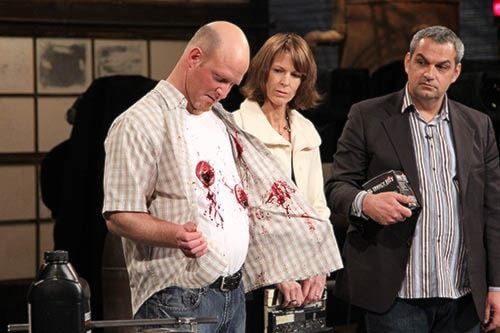Martin Testa’s job can be a little messy.
As a licensed pyrotechnician and special effects tech in the film and television industry, Testa’s success depends on how realistic his work comes across on screen.
So when the Maple Ridge resident was faced with a special, and unexpected request from a director, the ensuing panic and chaos struck Testa with a revolutionary idea.
Testa is now the owner and founder of Direct Hit FX, a Vancouver based start-up company that has its sights set on revolutionizing the film and television special effects industry.
To do it, he’s hoping he can conquer the Dragons’ Den on the CBC on Wednesday.
Testa is set to launch his Rapid Reload II, the technology used to vividly portray realistic bullet hits on the big and small screen.
Bullet hits on the screen have been hand-crafted since 1967, when Warren Beatty shocked the world with the bloodiest shootout in Bonnie and Clyde. While effective, Testa said it is a slow and time consuming venture.
Testa first envisioned the product when Vancouver director Terry Ingram asked for an unanticipated fourth take while shooting a movie in Maple Ridge. The special effects team had to scramble to handcraft another new device. With 20 minutes lost time and a crew of 40 standing on a rooftop in the rain, Testa was struck by the insanity. He said on big budget films, there’s always a budget to do more. But on a smaller scale productions, timelines and budgets are tight.
According to Linda Watt, CEO of Rapid Reload II, the preassembled bullet hit can be rigged and assembled in less than three minutes.
“This saves on precious production time, and that translates into enormous cost savings.”
Testa hopes the industry follows.
“Time is money on a film set,” said Testa. “The faster I can get the shot ready or reset to shoot again, the happier they’ll be. “
Ingram said he’s thankful for Testa’s epiphany, back in 2009. Like many directors, he prefers the real thing over computer generated models.
“In most circumstances, CGI simply can’t provide the same sense of realism,” said Ingram. “Using real squibs also keeps the creative process on set, allowing greater creative control and better reactions from the actors getting shot. There’s nothing like having a small explosive on your chest to react to.”
Testa set out to develop his first incarnation of what became called Rapid Reload technology, knowing that it would ultimately preserve the sense of realism in film and television and curb the further encroachment of computer generated images. He’s not naive enough to think he can halt the tide of CGI, but he knows if he can develop a quality product, there will be plenty of room for both.
“I come from the world where it’s go big or go home,“ he said
The budding new technology has had an enormous interest and buy-in from pyrotechnic specialists and producers looking to reduce production costs with a standardized product line that saves time and provides consistent results, said Testa.
In an era of shrinking budgets, the technology also promises to protect on-set jobs.
Testa, Watt and corporate director Chris Gielnik took the original Rapid Reload to the Dragon’s Den last April, and it’s been a whirlwind ever since. They’ve listened to industry feedback, and Testa and his new team have designed an improved version of the original.
“The new version delivers a bigger bang and more blood splatter than the original.”
And in Hollywood, what more can you ask for.
